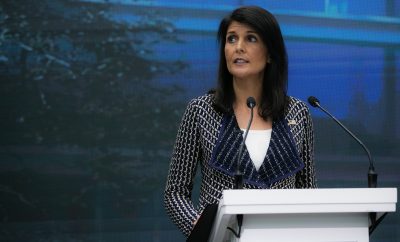 Image courtesy of [Moyan Brenn via Flickr]
Image courtesy of [Moyan Brenn via Flickr]
Energy and Environment
Was the Paris Climate Agreement a Success?
On Saturday, 195 countries managed to reach an unprecedented climate change agreement that intends to unite the international community around the goal of reducing emissions and preventing the most severe consequences of global warming. But despite the agreement, much work remains to be done to meet previously established targets. So was this agreement a success and will it solve climate change?
The short answer to that questions is yes and no–the agreement was in some ways a success, but it won’t solve climate change by itself. Evaluating climate change progress is particularly difficult because there are multiple ways to measure success. Committing all countries to the goal of limiting climate change is a massive step forward that should not be understated, but if you ask climate scientists, it is becoming increasingly unlikely that the world will be able to meet its intent to limit global temperatures to 2°C (3.6°F), above pre-industrial levels.
Let’s first look at what the agreement will require and where some gray areas remain. The legally-binding portion of the agreement mandates that all countries must submit plans to reduce their emissions, consistently monitor their progress, and then regularly report reductions to the international community. The agreement outlines a plan for regular international meetings at which additional measures will be discussed. While that step, by itself, is significant, the agreement has no binding mechanism to compel countries to meet their own standards. Moreover, based on the 185 plans that were submitted before the Paris conference, global warming will most likely continue past the agreed upon goal of 2°C.
If we proceed according to each country’s emissions plans, formally referred to as the intended nationally determined contributions (INDCs), temperatures will rise an estimated 3.5°C, but due to uncertainty in predictions, it could be as much as 4.6°C (Take a look at this graphic from the Climate Interactive for a visual representation). Because counties must track and update their emissions progress, countries could conceivably change their targets to become much more ambitious, making the 2°C goal attainable. But doing so would take a massive amount of political will and would need to happen sooner rather than later. The Climate Interactive refers to that as the “Ratchet Success” scenario. Check out this explanation to see what that would actually entail.
It is appropriate to question whether 2°C is a reasonable goal, as it was created somewhat arbitrarily. But the available evidence suggests that once the earth warms to that point significant changes will occur. Vox’s Brad Plumer has a pretty succinct breakdown:
Critics grumbled that the 2°C limit seemed arbitrary or overly simplistic. But scientists were soon compiling evidence that the risks of global warming became fairly daunting somewhere above the 2°C threshold: rapid sea-level rise, the risk of crop failure, the collapse of coral reefs. And policymakers loved the idea of a simple, easily digestible target. So it stuck.
While the 2°C threshold marks a certain point of no return for some climate-related consequences, scientists argue that significant effects will likely come before the earth warms that much. Generally, predicting the exact temperature at which changes will occur is difficult because rising temperatures could actually accelerate warming even further. Some manifestations of climate change, like permafrost melting, could actually speed up warming, which can be difficult for models to account for. Most models give a range for the potential consequences of warming, but even those may be revised upwards.
While it’s clear that in order to meet the U.N.’s target of 2°C much more needs to be done, that does not render the recent Paris agreement useless. The mere fact that nearly every major country has committed to reducing global warming is a significant achievement. This is particularly true when you look at the history of these talks and how they have failed in the past.
There have been several monumental steps that made the recent Paris deal possible in the first place. An agreement between the two largest CO2 emitters, the United States and China, bridged some of the disagreement between developed and developing countries. China recently announced a plan to let its emissions peak by 2030 and began working on a cap and trade system to do so. The Obama administration created a stringent Clean Power Plan, which aims to reduce electricity sector emissions by 32 percent from 2005 levels by the year 2030, as well as a 26 percent reduction in all emissions before 2025. Moreover, the fact that 185 countries managed to commit concrete plans to reduce their emissions is a remarkable a show of international commitment.
Despite recent progress, there are several key obstacles that remain in the way of a meaningful solution, arguably the most notable of which is the U.S. Congress. While negotiators were working in Paris to hash out a deal, the Republican-led Congress sought to dispel any optimism that might come from the deal. Earlier this month, the Republican party held a, notably symbolic, vote to block President Obama’s clean energy plan. Afer the Paris agreement was reached, Senate Majority Leader Mitch McConnell said,
Before his international partners pop the champagne, they should remember that this is an unattainable deal based on a domestic energy plan that is likely illegal, that half the states have sued to halt, and that Congress has already voted to reject.
While the stark disagreement between Republicans and the rest of the world on climate change hasn’t stopped all U.S. attempts to reduce emissions, a comprehensive strategy will need support from Congress. President Obama has largely managed to pursue his clean energy agenda through executive action, but when he leaves office the next president could easily reverse his progress. Another key part of the Paris agreement is the goal to provide $100 billion in climate-related aid to developing countries, yet U.S. funding for that must be approved by Congress. It’s true that the most important parts of the Paris agreement are not legally binding–there is no way to punish a country that does not meet its emissions plan–but that is largely a result of political reality.
So yes, the Paris agreement was a success in the sense that it marks a historic commitment to fight global climate change. The United Nations received climate reductions plans from 185 countries, which will continue to be revised and monitored in an effort to mitigate the negative effects of global warming. But at the same time, it is becoming increasingly clear that we will not meet our established goal to limit warming to 2°C. More to the point, there are several significant barriers to enacting the legislation needed to reduce emissions and transition to clean energy. Perhaps the Paris agreement is accurately a starting point, and if the international community is able to build momentum going forward, pressure could help force necessary change.








Comments